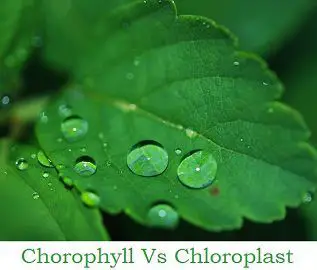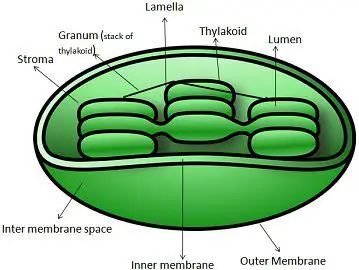Chlorophyll is the food producers of the cell found in green plants, they are present inside the chloroplast. Chlorophyll plays a vital role in turning plants green and healthy. While chloroplast is a unique organelle found in all green plants and is the location of photosynthesis to occur where the green plants can convert sunlight into chemical energy. Chlorophyll is found in the mesophyll cells in green plants leaves. The chloroplast is found in the dense fluid part of the chloroplast.
The main role of chloroplasts is to carry out the photosynthesis, containing many reactions like Light reaction and carbon assimilation reaction. Hence we can say that entire process of photosynthesis takes place in chloroplasts, whereas the role of chlorophyll is to reflect green color and absorbs blue and red wavelength. Like that of mitochondria, chlorophyll is called the ‘powerhouse‘ of the cell, as it is only responsible for ATP synthesis and other reactions.
One should have the basic knowledge of cells in order to understand their organelles and its functions deeply. As we know both chlorophyll and chloroplast are parts of a plant cell, and not of animal cells. In the provided article we will consider the difference between both entities along with the general discussion on them.
Content: Chlorophyll Vs Chloroplast
Comparison Chart
| Basis For Comparison | Chlorophyll | Chloroplast |
|---|---|---|
| Meaning | The chlorophyll is a pigment which gives green colour to the plants. | Chloroplast is an organelles or membrane present in the plant cell and the site of photosynthesis. |
| Kinds | Two kinds (a and b) | No kinds. |
| Role | Chlorophyll is the pigment involved in the process of photosynthesis. | Chloroplast is the organelle involved in photosynthesis. |
| Part of | Chlorophyll are the part chloroplast. | Chloroplast are the part of plant cell. |
| Pigments | Green pigments and carotenoids which has red and yellow pigments. | Chloroplast do not have such pigments. |
| Their presence | Chlorophyll are present inside the chloroplast, in the thylakoid membranes. | Assembly of chloroplast are higher, throughout the plant cell especially in leaves. |
| Found in | All plants, algae and cyanobacteria. | All plants and algae. |
| Contains | Do not contains their own DNA. | Contains their own organelle DNA called cpDNA. |
Definition of Chlorophyll
Chlorophyll is a vital plant molecule, that plays an important role in mixing and arranging the plant’s food in the process called photosynthesis. It has a similar structure to that of heme group of hemoglobin and cytochromes and is derived from protoporphyrin which contains polycyclic, plana tetrapyrrole ring.
Photosynthetic organisms contain various types of chlorophyll such as Chl a, Chl b, Chl c, Chl d. These molecules differ in their substituents group on the tetrapyrrole ring. It contains
1.The central metal ion as Mg2+.
2.A cyclopentanone ring attached with a carboxylic ester group, with pyrrole ring fused to it.
3.The pyrrole ring IV of Chl a and Chl b contains two extra hydrogen atoms. In bacteriochlorophylls rings, II and IV are in reduced form.
Chlorophyll mostly absorbs in blue and somewhat red portions of the electromagnetic spectrum, hence it reflects green color. In producer (autotrophs) these green color traps light energy from the sun, which combines with carbon dioxide and water into sugars.
This process is for the preparation of food in photosynthesis and further, it helps in gaining energy for the body growth. That’s why chlorophyll is called light-absorbing pigment or photoreceptor.
Definition of Chloroplast
Like mitochondria, they (chloroplast ) are also bounded by a double membrane, the outer membrane, and the inner membrane. The outer membrane is believed to be the origin of eukaryotic cells and is permeable to small molecules and ions. While the inner membrane encloses the internal compartment. The fluid inside the double-membrane is called stroma.
This compartment contains floating, flattened, tiny membranes surrounding vesicles or sacs called thylakoids. These are arranged in a groups called granum.
There are numerous grana present in each chloroplast and are interconnected by stromal lamellae. The thylakoid membrane (lamellae) are the site of Light reaction and ATP synthesis. The lipids present in the thylakoid membrane contains 80% uncharged mono- and di galactosyl diacylglycerol and about 10% is phospholipids.
Whereas the aqueous phase of the inner membrane – the stroma contains most of the enzymes required for carbon assimilation. Thus thylakoid membrane present in the chloroplast is the location for ATP synthesis and Light reactions. This ATP is used by stroma to store trapped energy in the form of carbon-carbon bonds of carbohydrates.
As Chloroplast is found in bacteria, it divides by the process of binary fission, as occur in bacteria. The chloroplast is considered as the semi-autonomous structure and contains 70S ribosomes (prokaryotic-type).
Key Differences Between Chlorophyll and Chloroplast
Following are the key differences between chlorophyll and chloroplast:
- Chlorophyll is pigment which gives a green color to the plants, by absorbing the wavelength of red and blue and reflecting green; Chloroplast is the site of photosynthesis and other chemical reactions like light and carbon-assimilation reaction, even chlorophyll is found in layers of the chloroplast.
- Mainly chlorophyll is of two types which are Chl a and Chl b, but there are no such kinds of chloroplast though they are present in number in plant cells.
- Chlorophyll is found in all plants, algae, and cyanobacteria while chloroplast is found in all plants and algae.
- Chlorophyll contains green pigments and carotenoids which have red and yellow pigments; while chloroplast does not have any pigments.
- Chlorophyll does not have their own DNA; Likewise mitochondria, chloroplast contains their own organelle DNA called cpDNA.
- The presence of chlorophyll is marked inside the chloroplast, in the thylakoid membranes, whereas assembly of the chloroplast is higher, throughout the plant cell especially in leaves.
Conclusion
We can say that there are many distinguishing features found in plant cell and animal cell structure, like chlorophyll and chloroplast which are present only in the plant cell, especially in green plants.
Chlorophyll is the part of chloroplast and is the light absorbing pigments which provide green color to the plants, but chloroplast traps the solar energy, which is the site of photosynthesis and other chemical reactions and works as the ‘powerhouse of the cell’ like mitochondria.



Leave a Reply